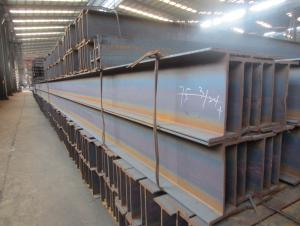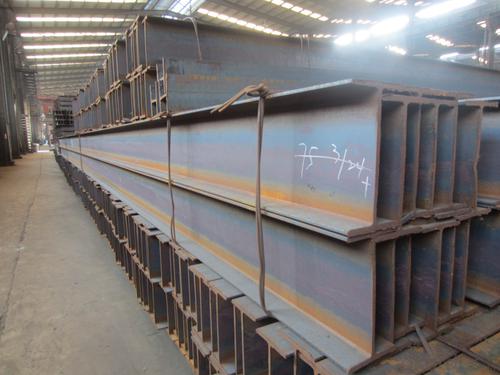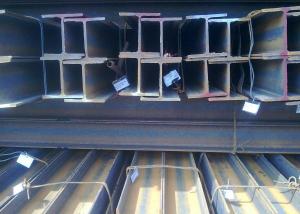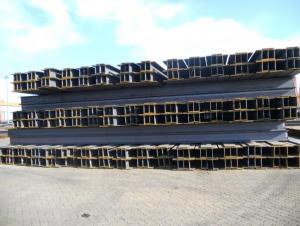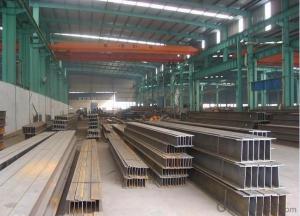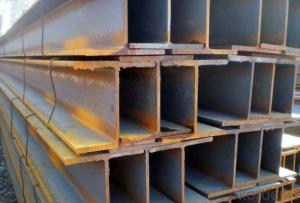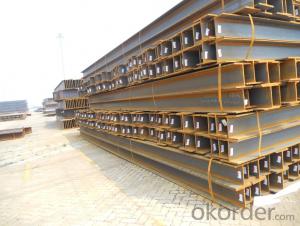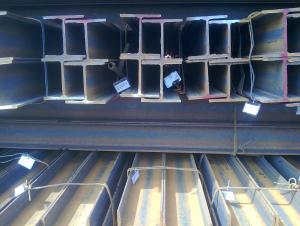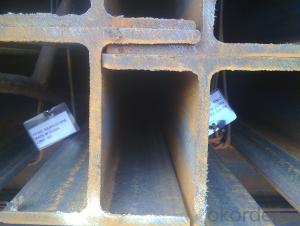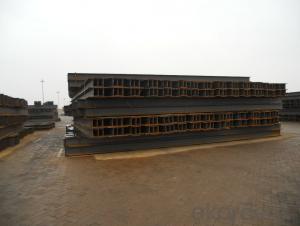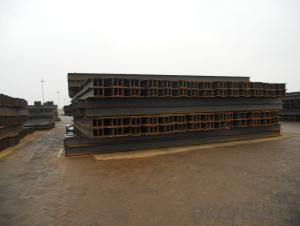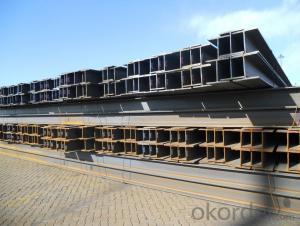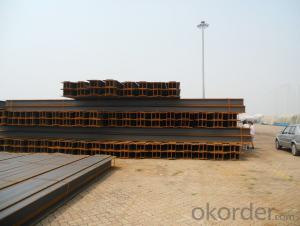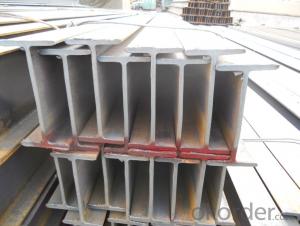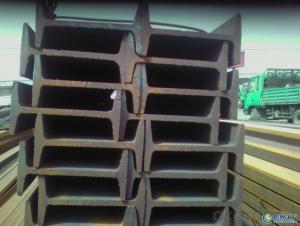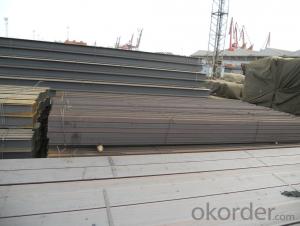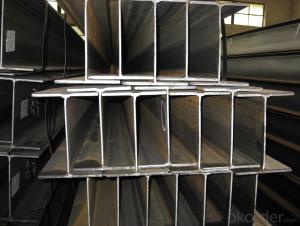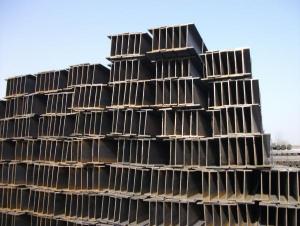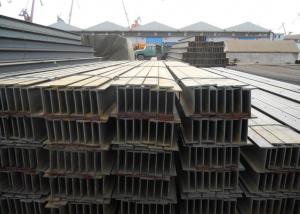JIS Standard Hot Rolled Steel H Beams of Material SS400
- Loading Port:
- Tianjin
- Payment Terms:
- TT OR LC
- Min Order Qty:
- 25 m.t.
- Supply Capability:
- 200000 m.t./month
OKorder Service Pledge
OKorder Financial Service
You Might Also Like
Specifications of JIS Standard Hot Rolled Steel H Beams of Material SS400
1. Standard: JIS G3101, SS400(1987),GB700-88, Q235B,EN10034-1993 / EN10025-2004,
HEA100-HEA500,HEB100-HEB500
2. Grade: Q235, SS400 or Equivalent
3. Length: 6m,10m, 12m as following table
4. Invoicing on theoretical weight or actual weight as customer request
5.Payment: TT or L/C
6. Sizes:
SIZE(mm) | DIMENSION(kg/m) |
100*100 | 16.9 |
125*125 | 23.6 |
150*75 | 14 |
150*150 | 31.1 |
148*100 | 20.7 |
198*99 | 17.8 |
200*100 | 20.9 |
248*124 | 25.1 |
250*125 | 29 |
300*150 | 36.7 |
298*149 | 32 |
200*200 | 49.9 |
294*200 | 55.8 |
346*174 | 41.2 |
350*175 | 49.4 |
244*175 | 43.6 |
175*175 | 40.4 |
294*200 | 55.8 |
298*201 | 64.4 |
346*174 | 41.2 |
350*175 | 49.4 |
400*200 | 65.4 |
396*199 | 56.1 |
450*200 | 74.9 |
446*199 | 65.1 |
340*250 | 78.1 |
500*200 | 88.1 |
300*150 | 36.7 |
Usage & Applications of JIS Standard Hot Rolled Steel H Beams of Material SS400
Commercial building structure ;Pre-engineered buildings; Machinery support structure; Prefabricated structure; Medium scale bridges; Ship-building structure. etc.
Packaging & Delivery of JIS Standard Hot Rolled Steel H Beams of Material SS400
1. Packing: it is nude packed in bundles by steel wire rod
2. Bundle weight: not more than 3.5MT for bulk vessel; less than 3 MT for container load
3. Marks:
Color marking: There will be color marking on both end of the bundle for the cargo delivered by bulk vessel. That makes it easily to distinguish at the destination port.
Tag mark: there will be tag mark tied up on the bundles. The information usually including supplier logo and name, product name, made in China, shipping marks and other information request by the customer.
If loading by container the marking is not needed, but we will prepare it as customer request.
4. Transportation: the goods are delivered by truck from mill to loading port, the maximum quantity can be loaded is around 40MTs by each truck. If the order quantity cannot reach the full truck loaded, the transportation cost per ton will be little higher than full load.
5. Delivered by container or bulk vessel
Production flow of JIS Standard Hot Rolled Steel H Beams of Material SS400
Material prepare (billet) —heat up—rough rolling—precision rolling—cooling—packing—storage and transportation
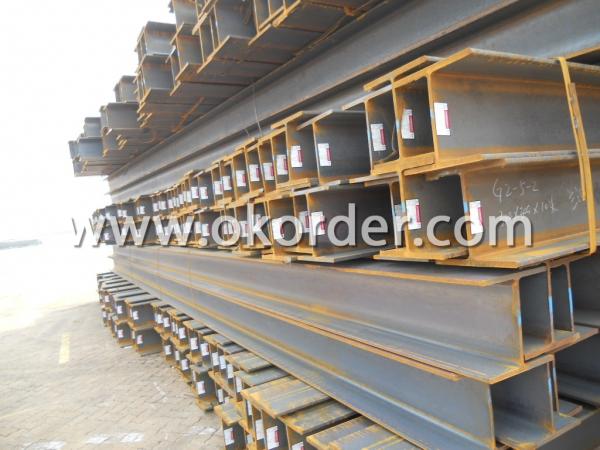
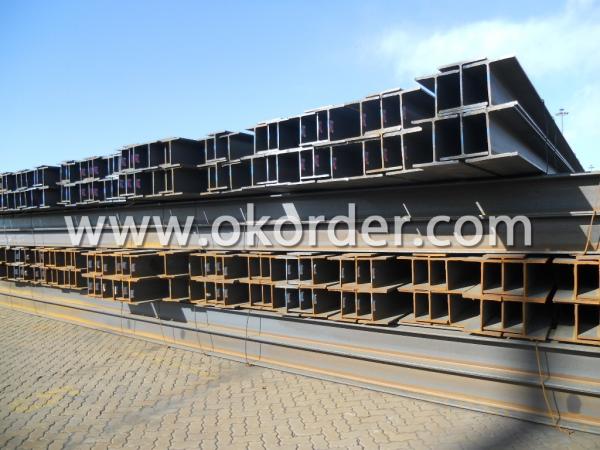
- Q: How do steel H-beams compare to timber or concrete beams?
- Steel H-beams have several advantages over timber or concrete beams. Firstly, steel H-beams are much stronger and more durable than timber or concrete beams. Steel has a higher strength-to-weight ratio, meaning that it can support heavier loads while being lighter in weight. This allows for longer spans and larger open spaces in construction. In contrast, timber beams are prone to warping, rotting, or insect damage, while concrete beams may crack or deteriorate over time. Secondly, steel H-beams are more resistant to fire and other extreme conditions. Steel has a high melting point and does not burn, making it a safer choice in case of fire accidents. Timber beams, on the other hand, are highly flammable and can contribute to the rapid spread of fire. Concrete beams may also crack and fail under extreme heat or cold conditions. Furthermore, steel H-beams offer better flexibility and versatility in design. They can be easily fabricated into various shapes, sizes, and lengths to meet specific project requirements. Steel beams also have consistent dimensions, allowing for easier and faster installation. In contrast, timber beams are limited in terms of available sizes and may require additional processing. Concrete beams are typically cast on-site, which can be time-consuming and labor-intensive. Lastly, steel H-beams have a longer lifespan and require less maintenance compared to timber or concrete beams. Steel is resistant to corrosion, rot, and decay, making it a more durable and cost-effective choice in the long run. Timber beams need regular inspections, treatments, and replacements to maintain their structural integrity. Concrete beams may develop cracks or require repairs over time. In summary, steel H-beams offer superior strength, durability, fire resistance, design versatility, and low maintenance compared to timber or concrete beams. These advantages make steel H-beams a preferred choice in many construction projects, especially those with higher load-bearing requirements or in locations prone to extreme conditions.
- Q: Are steel H-beams suitable for supporting mezzanine storage systems?
- Yes, steel H-beams are suitable for supporting mezzanine storage systems. Steel H-beams are known for their strength and durability, making them an ideal choice for supporting heavy loads such as mezzanine storage systems. Additionally, steel H-beams provide stability and structural integrity, ensuring the safety and stability of the mezzanine storage system.
- Q: How do steel H-beams compare to other structural beams?
- Steel H-beams are widely regarded as one of the most efficient and effective structural beams available. They offer several advantages over other types of beams, including their high strength-to-weight ratio, versatility, and cost-effectiveness. Firstly, the high strength-to-weight ratio of steel H-beams makes them incredibly strong and durable while also being relatively lightweight. This allows for the construction of large and complex structures without adding excessive weight, reducing the overall cost and making them easier to transport and install. In addition, steel H-beams have a unique shape that provides excellent load-bearing capabilities. The H shape distributes the weight evenly along the beam, allowing it to support heavy loads and resist bending or twisting. This makes them ideal for use in structures that require long spans or heavy loads, such as bridges, skyscrapers, and industrial buildings. Furthermore, steel H-beams are highly versatile and adaptable. They can be easily customized and fabricated to meet specific design requirements, allowing for the creation of structures of various shapes and sizes. Additionally, they can be joined together using welding or bolting methods, providing flexibility during construction and allowing for modifications or extensions in the future. Another advantage of steel H-beams is their cost-effectiveness. While initial costs may be higher compared to some other materials, the long-term benefits outweigh the investment. Steel is highly durable and resistant to corrosion, reducing maintenance and replacement costs over time. Moreover, its recyclability makes it an environmentally friendly choice. Overall, steel H-beams offer numerous advantages over other structural beams, including their high strength-to-weight ratio, versatility, and cost-effectiveness. These factors make them a popular choice in various construction projects and contribute to their widespread use in the industry.
- Q: Model H is 580*280*12*14. How much is the theoretical weight of the steel?It's better to list the complete formula, thank you!
- Sectional area=(H+2T =(TW)2bt 580×2×14)+2×280×12×14 = 144.64cm2
- Q: 248 H steel GB thickness?
- The section is 248mm high, the section width is 124mm, the web thickness is 5mm, and the flange thickness is 8mm.
- Q: What is the difference between hot-rolled and cold-formed steel H-beams?
- H-beams made of steel can be produced using two different methods: hot-rolling and cold-forming. These methods result in H-shaped cross-section beams that have distinct characteristics. Hot-rolled steel H-beams are created by heating a large steel billet or ingot to extremely high temperatures and then shaping it through rolling. This process involves intense heat, making the steel more malleable and easier to shape. As a result, the finished product has a rougher surface texture. Hot-rolled H-beams typically have wider flanges and thicker webs compared to cold-formed H-beams. They are commonly used in heavy-duty construction projects that require high strength and load-bearing capacity. On the other hand, cold-formed steel H-beams are manufactured by shaping cold-rolled or galvanized steel coils into the desired H-shaped profile. This process takes place at room temperature, without the use of heat. Cold-formed H-beams have a smoother surface finish and more precise dimensions compared to hot-rolled beams. They also tend to have thinner flanges and webs, making them lighter and more suitable for applications where weight reduction is important. Cold-formed H-beams are commonly used in light to medium-duty construction, such as residential buildings and infrastructure projects. In terms of mechanical properties, hot-rolled H-beams generally have higher yield and tensile strength compared to cold-formed H-beams. This is because the intense heat during the hot-rolling process allows the steel to undergo grain refinement and achieve better mechanical properties. On the other hand, cold-formed H-beams usually have lower strength but higher ductility and toughness. They can deform more before failure, making them more resistant to bending and deformation. In summary, the main differences between hot-rolled and cold-formed steel H-beams lie in the production process, surface finish, dimensions, and mechanical properties. Hot-rolled beams are produced at high temperatures, have a rougher surface, and are used in heavy-duty construction. Cold-formed beams are manufactured at room temperature, have a smoother surface, and are suitable for lighter construction applications.
- Q: Are steel H-beams cost-effective compared to other beam options?
- Yes, steel H-beams are generally considered to be cost-effective compared to other beam options. There are several factors that contribute to this cost-effectiveness. Firstly, steel H-beams offer a high strength-to-weight ratio, meaning they can support heavy loads while being relatively lightweight themselves. This can result in cost savings in terms of transportation and installation, as well as reduced foundation requirements. Additionally, steel H-beams are durable and have a long lifespan. They are resistant to corrosion, fire, and pests, which means they require minimal maintenance and replacement over time. This can result in significant cost savings in terms of ongoing maintenance and repairs. Furthermore, steel H-beams are readily available and easy to manufacture. This means they can be produced in large quantities at a relatively low cost, making them more affordable compared to other beam options. The availability of standardized sizes and shapes also contributes to their cost-effectiveness, as it simplifies the design and construction process. It is important to note that the cost-effectiveness of steel H-beams can vary depending on the specific project requirements and the local market conditions. However, in general, steel H-beams offer a combination of strength, durability, and affordability that makes them a cost-effective choice for many construction projects.
- Q: Are there any regulations or standards for using steel H-beams in construction?
- Steel H-beams in construction are subject to regulations and standards, which differ depending on the country and region. These regulations ensure the safe and effective use of H-beams in building structures. In the United States, the American Institute of Steel Construction (AISC) is responsible for providing standards for steel construction, including H-beams. The AISC's Manual of Steel Construction outlines the criteria for design, fabrication, and safety considerations when using H-beams in construction. These standards cover topics such as material specifications, design principles, welding procedures, and quality control measures. Similarly, in Europe, the European Committee for Standardization (CEN) has developed the Eurocodes, which are a set of harmonized technical rules for the design of structures, including steel H-beams. The Eurocodes cover various aspects of construction, including structural design, material properties, and construction execution. The Eurocodes ensure that H-beams used in construction projects meet the necessary safety, performance, and durability standards. Different regulations and standards exist in other countries and regions for the use of steel H-beams in construction. These standards typically address issues such as material properties, structural design criteria, fabrication and construction practices, and quality control measures. Compliance with these regulations is crucial for contractors, engineers, and designers to ensure the structural integrity and safety of buildings that use steel H-beams. To ensure compliance with all applicable regulations and standards, it is important to consult the relevant local building codes and standards. Additionally, engaging the services of qualified professionals, such as structural engineers, during the design and construction stages is highly recommended.
- Q: How do steel H-beams compare to concrete beams in terms of cost and durability?
- Steel H-beams generally offer a more cost-effective option compared to concrete beams due to their lower material costs and quicker installation. Additionally, steel beams are highly durable and can withstand heavy loads and extreme conditions better than concrete beams.
- Q: How do steel H-beams perform in terms of seismic resistance?
- Steel H-beams perform exceptionally well in terms of seismic resistance. Their strong and rigid structure allows them to effectively dissipate and absorb seismic energy during earthquakes, minimizing damage to the building. Additionally, steel H-beams are highly ductile, meaning they can deform without fracturing, further enhancing their seismic performance. These factors make steel H-beams a preferred choice for seismic-resistant construction.
Send your message to us
JIS Standard Hot Rolled Steel H Beams of Material SS400
- Loading Port:
- Tianjin
- Payment Terms:
- TT OR LC
- Min Order Qty:
- 25 m.t.
- Supply Capability:
- 200000 m.t./month
OKorder Service Pledge
OKorder Financial Service
Similar products
Hot products
Hot Searches
Related keywords
